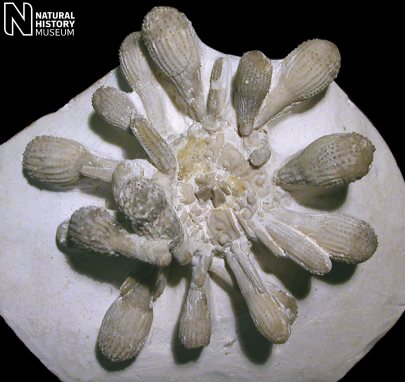 A A |
 B B |
 C C |
 D D |
 E E |
|
Tylocidaris (Tylocidaris) clavigera (Mantell, 1822) |
The highly characteristic club-like primary spines of Tylocidaris clavigera are frequently encountered within the Coniacian of the White Chalk Subgroup, though the species ranges from the Late Turonian to the Santonian. The spines of the closely related Tylocidaris velifera are very similar, but T. velifera is restricted to the Grey Chalk.
 A A |
 B B |
 C C |
 D D |
 E E |
1). (A) Adoral view of a spectacularly preserved individual with articulated primary spines and lantern (x1.3, White Chalk, 'Senonian' (Coniacian-Campanian), Woolwich, Kent, BMNH (British Museum (Natural History) London) 33455); (B-E) Examples of the variably-formed primary spines (x2.5), Randell Collection, (B) RR0862 (C) RR0862 (D) RR0797 (E) RR0796. Image (A) © 2008 The Natural History Museum, by kind permission.
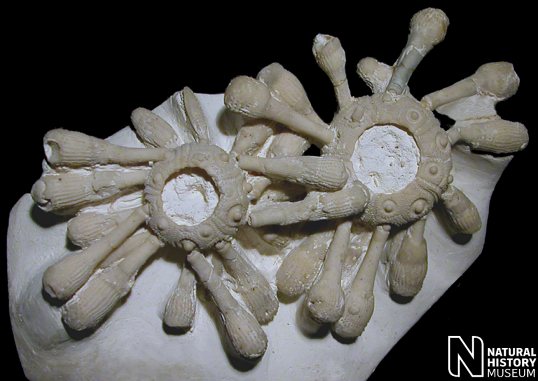
2). A remarkable specimen - an interlocked pair of large individuals with articulated primary spines. Adoral surfaces exposed. Collected and prepared by the famous chalk biostratigrapher Arthur Rowe (x1.2, White Chalk, Seaford Chalk, North Foreland, Thanet coast, Kent, BMNH (British Museum (Natural History) London) E39920). Image © 2008 The Natural History Museum, by kind permission.
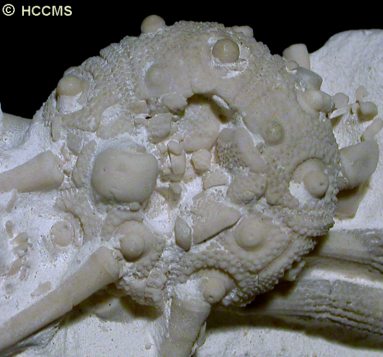 A
A |
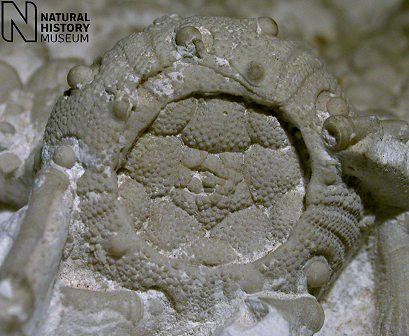 B B |
3). Specimens with exceptionally well preserved apical discs; (A) x3.0, White Chalk, in the collection of Gosport Museum, G.1982.75, by kind permission of Dave Kemp, HCCMS (Hampshire County Council Museum's Service); (B) x4.0, White Chalk, Charlton, BMNH (British Museum (Natural History) London) 31190. Image © 2005 The Natural History Museum, by kind permission.
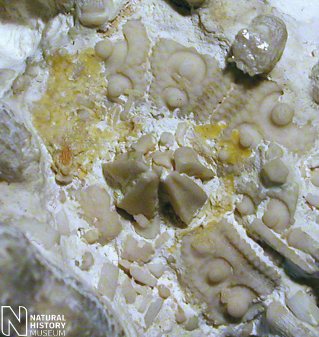 A
A |
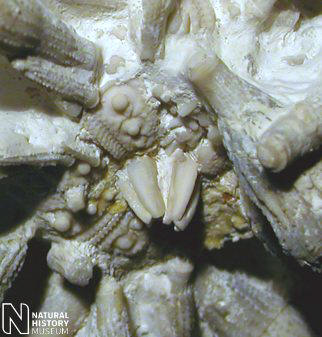 B B |
4). (A,B) Details of the adoral surface of a well preserved individual, with an articulated lantern protruding from the peristome (White Chalk, 'Senonian' (Coniacian-Campanian), Woolwich, Kent, BMNH (British Museum (Natural History) London) 33455); (A) x3.0; (B) x2.5. Images © 2008 The Natural History Museum, by kind permission.
 A
A |
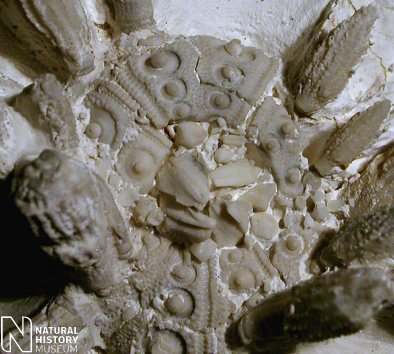 B B |
5). Adoral views of well preserved individuals with lanterns protruding from the peristome; (A) x3.0, White Chalk, in the collection of Gosport Museum, G.1981.176, by kind permission of Dave Kemp, HCCMS (Hampshire County Council Museum's Service); (B) x3.0, White Chalk, BMNH (British Museum (Natural History) London) E184. Image © 2008 The Natural History Museum, by kind permission.
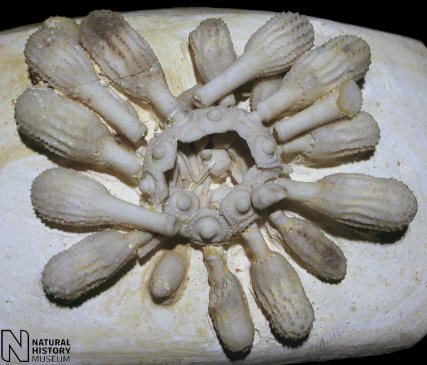 A A |
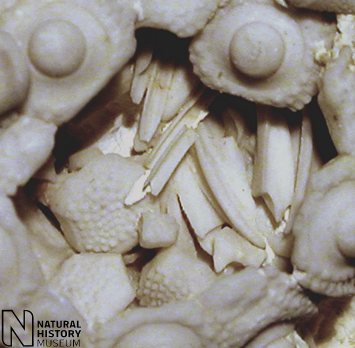 B B |
6). Adapical view of a spectacular specimen, with articulated primary spines and a collection of apical disc and lantern elements exposed on the floor of the test (White Chalk, BMNH (British Museum (Natural History) London) E184 (note: same specimen number as Fig. 5B(?))); (A) Overview of the specimen (x2.0); (B) Detail, looking through the periproct to view the collection of apical and lantern elements (x6.0). Images © 2008 The Natural History Museum, by kind permission.
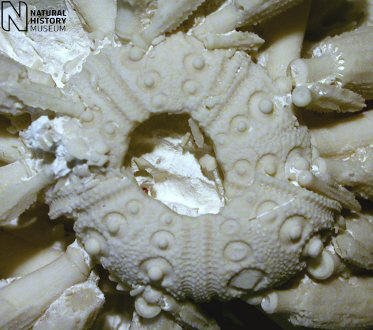 A
A |
 B B |
7). Adoral views of well preserved individuals; (A) x3.0, White Chalk, Seaford Chalk, Tarring Neville, near Newhaven, Sussex, BMNH (British Museum (Natural History) London) E79699; (B) x3.0, White Chalk, Coniacian/Santonian, Charlton, Kent BMNH E2027. Images © 2008 The Natural History Museum, by kind permission.
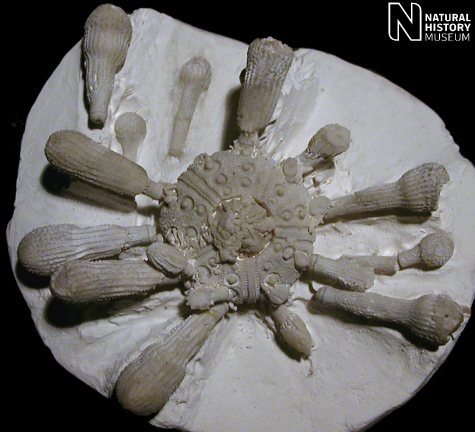
8). A classic specimen, exhibiting the adoral surface of a large individual with articulated parimary spines and a protruding lantern (x1.5, White Chalk, 'Senonian' (Coniacian-Campanian), Gravesend, Kent, BMNH (British Museum (Natural History) London) E39998. Image © 2008 The Natural History Museum, by kind permission.
 A A |
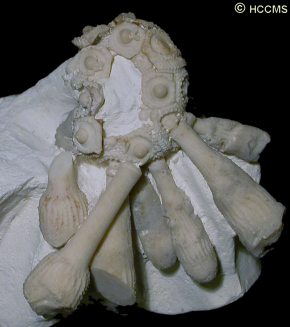 B B |
9). (A) Adoral view of a well preserved individual (x1.5, White Chalk, Seaford Chalk, Tarring Neville, near Newhaven, Sussex, BMNH (British Museum (Natural History) London) E79699). Image © 2008 The Natural History Museum, by kind permission; (B) Adapical view of an individual with articulated primary spines, but a laterally crushed test (x1.5, White Chalk, in the collection of Gosport Museum, G.1981.176, by kind permission of Dave Kemp, HCCMS (Hampshire County Council Museum's Service).
 A
A |
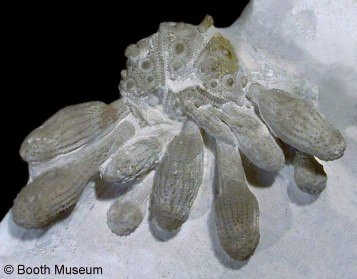 B B |
10). Adoral views of well preserved individuals; (A) surface of a well articulated specimen; (A) x1.7, White Chalk, Coniacian/Santonian, Charlton, Kent BMNH (British Museum (Natural History) London) E2027. Image © 2008 The Natural History Museum, by kind permission; (B) x2, Willett Collection, Booth Museum, BMB 007870, by kind permission of John Cooper.
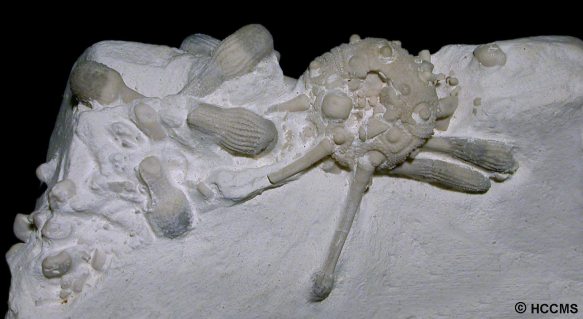
11). Adapical view of a well preserved individual with associated starfish ossicles, all perhaps entrained in burrow network? (see a similar specimen); x1.6, from the White Chalk and in the collection of Gosport Museum, G.1982.75, by kind permission of Dave Kemp, HCCMS (Hampshire County Council Museum's Service).
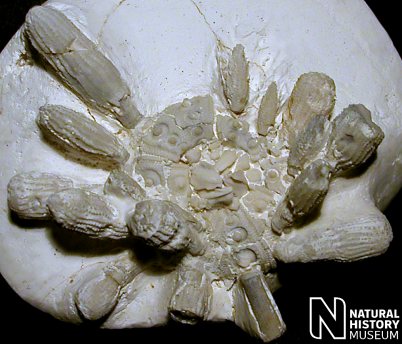 A A |
 B B |
12). Adoral views of well preserved individuals; (A) x1.4, White Chalk, BMNH (British Museum (Natural History) London) E184. Image © 2008 The Natural History Museum, by kind permission; (B) x2.3, encased in flint, White Chalk, Roy Shepherd Collection. Note curious absence of primary tubercles and areoles lower right centre of image. Image used by kind permission.
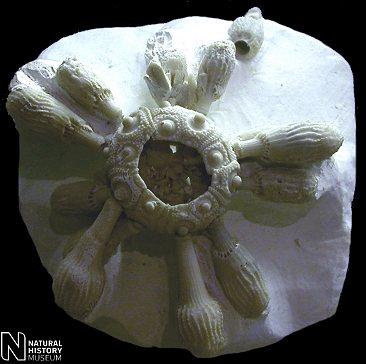 A
A |
 B B |
13). Adoral surface of a well articulated specimen; (A) general view (x1.4); (B) detail of the test, apical and periproctal plates have become disarticulated and collected inside the test (x4.0), White Chalk, Charlton, Kent, BMNH (British Museum (Natural History) London) display specimen. Image © 2006 The Natural History Museum, by kind permission.
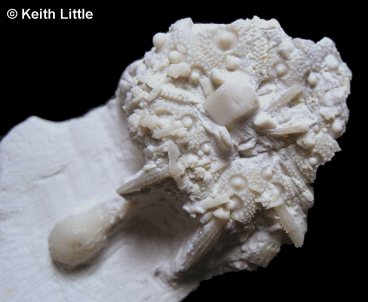 A A |
 B B |
14). Recent discoveries - Tests with associated spines viewed adorally: (A) Prepared specimen with associated starfish ossicle over the peristome (x2.3, Seaford Chalk, Thanet Coast, Kent, in the collection of Keith Little); (B) Specimen as found exposed in the field (x2.0, Seaford Chalk, Beachy Head, Sussex, Randell Collection). Image (A) © 2010 Keith Little, by kind permission; Image (B) courtesy of Joe Shimmin, by kind permission.
 A
A |
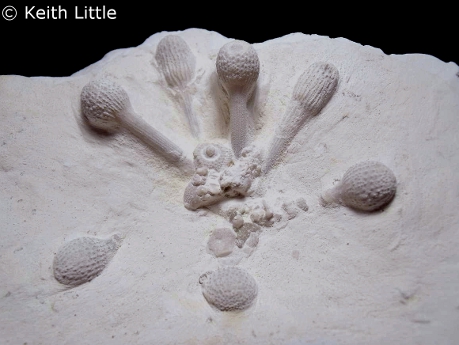 B B |
15). (A) Near complete compliment of primary spines and other skeletal elements, arranged in life position, but very curiously lacking the test; a possible interpretation is that post mortem, and once most of the connective tissues had decayed, the individual was rapidly buried, but this same influx of sediment swept the test away. Variation in spine form is well displayed; as the rod-like spines are on top we are clearly viewing the specimen from the underside (x1.7, White Chalk, HCCMS (Hampshire County Council Museum's Service) collection, stored at Gosport Museum, G.1981.223. (B) A similar specimen, with a compliment of primary spines in life arrangement but with the test largely absent (x1.7, Seaford Chalk, Thanet Coast, Kent, in the collection of Keith Little). Image (A) by kind permission of Dave Kemp, HCCMS; Image (B) © 2011 Keith Little, by kind permission.
|
|
 B B |
 A A |
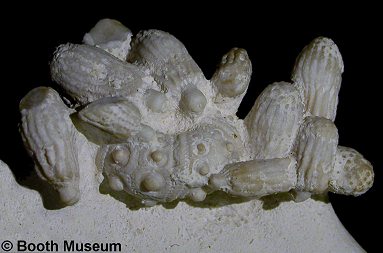 B B |
17). Adoral views of complete tests retaining a complement of primary spines; (A) Semi-articulated primary and scrobicular spines (x2.6, White Chalk, Booth Museum, BMB 024373, by kind permission of John Cooper); (B) Disarticulated primary spines and no scrobicular spines (x2.5, White Chalk, Willett Collection, Booth Museum, by kind permission of John Cooper).
 A A |
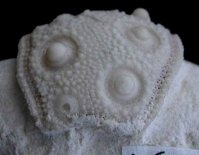 B
B |
 C
C |
 D D |
18). Test fragments, (Hope Gap, Lewes Nodular Chalk Formation, Beeding Beds.). (A-C) A test segment from an elderly individual of T. clavigera (x3) ; (A) adoral view; (B) adapical view; (C) ambital view. Characteristic features are the large primary tubercles, and the poor definition of interambulacral plates. Though most cidaroids have a single pore on the tip of each primary tubercle, pores are generally absent for T. clavigera. (D) Test fragment from a more juvenile individual (x6.5). Randell Collection, (A-C) RR1691, (D) RR1696.
19). Part of a well preserved individual, associated with the remains of a starfish (Crateraster quinqueloba). Perhaps both became entrained in burrow network, or maybe the echinoid was buried whilst scavenging on the starfish? (x1.6, White Chalk, HCCMS (Hampshire County Council Museum's Service) collection, stored at Gosport Museum, G.1984.350, by kind permission of Dave Kemp, HCCMS).
 A A |
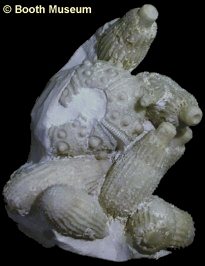 B B |
20). Tests with disarticulated primary spines and no scrobicular spines; (A) x1.8, White Chalk, Grant Museum; (B) x1.6, White Chalk, Booth Museum, BMB 024374, by kind permission of John Cooper).
 A A |
 B B |
21). Disarticulated specimens, Seven Sisters, Seaford Chalk Formation; (A) associated bulbous primary spines (x1.3), (B) an association of primary spines and other skeletal elements, the block has been encased in a plaster jacket and prepared by reversal (x0.9). Both Randell Collection, (A) RR1825, (B) RR1798.
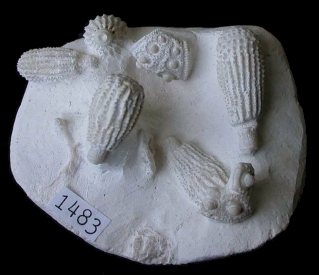 A A |
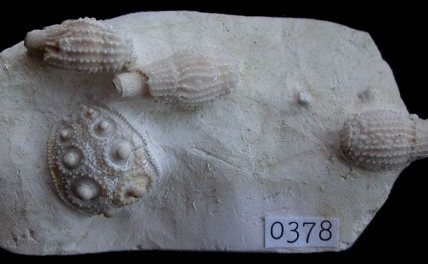 B B |
22). A typical specimens of T. clavigera, test fragments scattered amongst primary spines; (A) x2.5 (Hope Gap, Lewes Nodular Chalk Formation, Beeding Beds), (B) x2.5, no data. Both Randell Collection, (A) RR1483, (B) RR0378.